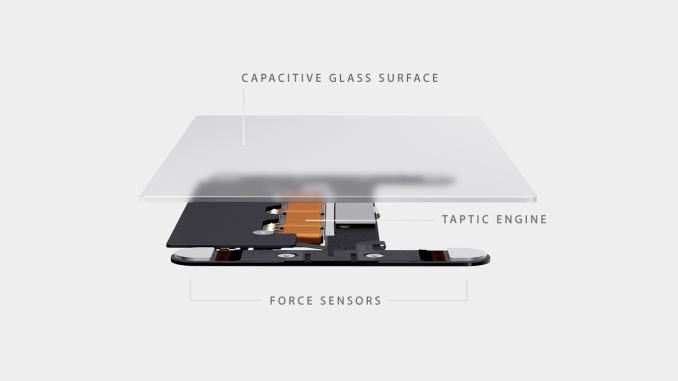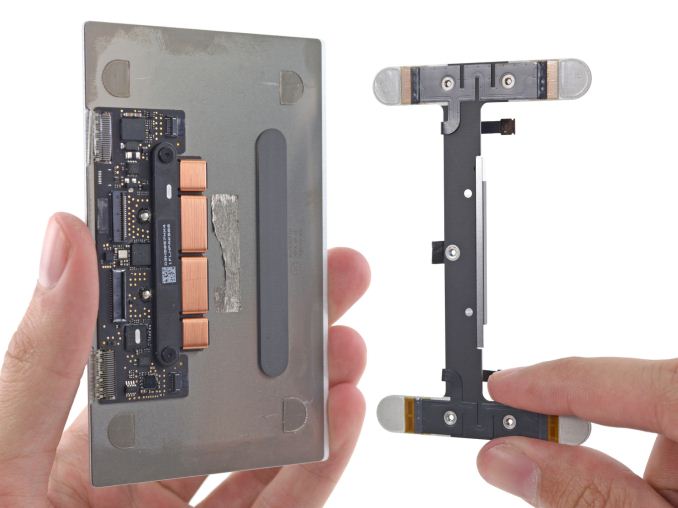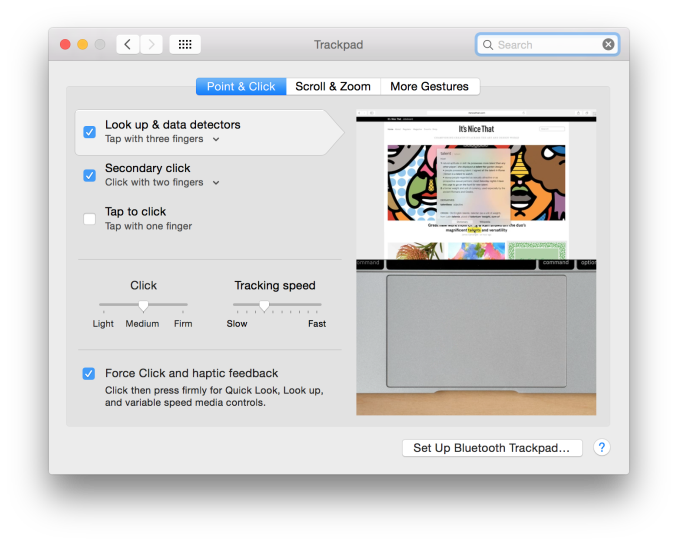The 2015 MacBook Review
by Ryan Smith on April 14, 2015 10:15 AM ESTForce Touch Trackpad
Along with Apple’s changes to their keyboard, the company has also gone in and significantly reworked their trackpad. The new Force Touch Trackpad represents the biggest change to Apple’s trackpad design since the creation of the capacitive, multi-touch pivoting trackpad introduced on the unibody MacBook Pro. In putting together the Force Touch Trackpad, Apple has significantly reworked the internals of the trackpad, creating a trackpad that behaves a lot like their traditional trackpad with some new features, but under the hood relies on some very different mechanisms.
The big change here is that Apple has done away with the traditional pivot and switch mechanism. With pivot and switch, the capacitive trackpad surface would act like a small touchscreen, and underneath it was a switch to register when the trackpad was pressed down. Mechanically the trackpad pivoted from the top (Apple likes to compare it to a diving board), with the trackpad inferring what action to take based on the combination of the capacitive readings and the switch reading. Multi-finger gestures would rely solely on the capacitive layer, primary/secondary clicks would be based on the number of fingers in use when the switch was actuated, etc.
The Force Touch Trackpad on the other hand eliminates the pivot and switch mechanism in favor of a combination of an electromagnet and force/pressure sensors. The pressure sensors essentially replace the physical switch, allowing the trackpad to tell when it has been pressed based on the amount of pressure, and thanks to the pressure sensors it can now tell how hard it has been pressed as opposed to the binary nature of the physical switch. Meanwhile without a physical switch in place to provide the clicking sensation and feedback of pressing down on the touchpad, Apple’s electromagnet – the Taptic Engine – activates to simulate the feeling and noise of pressing a switch.
Update 04/15/2015: iFixit has a great shot of the trackpad's internals, including a good look at just how big the electromagnet/taptic engine really is.
The end result is that the MacBook’s trackpad is among the first wave of devices that ships with Apple’s next generation trackpad and the enhanced capabilities that go with it. Ignoring the pressure sensitivity for a moment (we’ll get back to it), replacing the pivot and switch for an electromagnet works shockingly well. From a touch & feel standpoint the Force Touch Trackpad feels virtually identical to a traditional trackpad, to the point where it’s more than a bit uncanny. In practice you are not actually triggering a switch nor is the trackpad really moving (technically it’s deforming ever so slightly), but it sure feels like you’re working a switch. Apple has clearly done their homework on getting an electromagnet to emulate a switch, to great results. Meanwhile they don’t have the trackpad’s acoustics precisely matching a switch, but the resulting pinball-machine like plunk is close enough to a click that I don’t imagine anyone will mind the difference.
One side benefit of this change is that the trackpad feels the same throughout, and unlike the pivoting trackpad does not require more or less force depending on where you are relative to the pivot point. The variable force required has never been a major problem in my experience, but it is nice to no longer need to worry about where your fingers are relative to the top, and consequently how much force you need to use.
However the bigger deal is that by making the amount of force required to click consistent throughout the entire trackpad, Apple can now use the amount of pressure applied as another input, making the trackpad pressure-sensitive. The underlying pressure sensors and electromagnet are by default programmed to have two levels of feedback – a shallower press is equivalent to a click – and a deeper press brings about the pressure-sensitive “Force Click.” What force clicking does depends on the application, and right now it’s clear that Apple is still experimenting with what they can do with pressure sensitivity. The most obvious uses include line thickness in drawing applications, but the company is also using it for things such as variable speed fast forward and rewinding in QuickTime/iMovie. At times the force click is treated like a 3rd (tertiary) click, and other times the result is based on variable pressure. Since this is a new (and uncommon) feature there’s no global action assigned to the force click – nor does it behave as a middle click on a regular mouse – so what happens is up to the application.
In implementing force click and the Force Touch Trackpad, Apple does offer the ability to control the amount of pressure required and whether force click is active. With force click deactivated the trackpad behaves more or less identical to a traditional trackpad with a single click level. Meanwhile the click pressure setting is interesting, though I’m not entirely convinced it’s all that effective. Short of the tools to actually measure click pressure, I’m not so sure Apple is changing the amount of pressure required to trigger a click so much as they’re changing how hard the electromagnet vibrates. The feedback change is certainly very subtle going from light to firm, and if there is a change in the amount of pressure required then it is certainly equally subtle.
Ultimately whether the Force Touch Trackpad is a major upgrade or not is going to depend on a user’s ability to make use of the force click features. Even turned off, the new trackpad is essentially an improved version of the old trackpad without the minor drawbacks of the pivot mechanism. But with the force click turned on, then it brings new (though not always useful) actions to the trackpad that in turn makes it a bigger upgrade over the old trackpad.
In any case, the MacBook along with the 2015 MacBook Pro 13” are the first wave of devices to implement the new Force Touch Trackpad. Given its expanded capabilities I would expect Apple to eventually replace many (if not all) of their trackpads with this new design. Certainly the 15” MacBook Pro is a likely candidate, as is a future version of the Magic Trackpad. What remains to be seen is whether the next MacBook Air also gets this new trackpad, or if Apple withholds it to keep the products differentiated and to keep the costs of the MacBook Air down.














354 Comments
View All Comments
jospoortvliet - Wednesday, April 15, 2015 - link
relatively speaking it is almost a third heavier - that is far from insignificant. What matters on 500 gram doesn't on 500kg 😃VengenceIsMine - Tuesday, April 14, 2015 - link
While USB - C is going to be great, designing to the MacBook to just have 1 is a needless fail. Samsung's ATIV 12 is practically the same device: Same processor, same ram, SSD, screen size, almost same resolution, same weight and size and yet Samsung managed 2 USB 3.0 ports, power & micro HDMI. Huge difference in usability for those of us that have to interact will all sorts of devices, locations with iffy networks and people who haven't moved every aspect of their business to the cloud. Apple would likely say that the single port is more elegant but there is nothing elegant about needing a $80 dongle to plug in power and a USB stick at the same time.TEAMSWITCHER - Tuesday, April 14, 2015 - link
USB Stick? Have you never heard of Drop Box or One Drive or Google Drive or iCloud Drive? I think the point of only one port, is that the world has (almost completely) moved on from USB. Well, everyone except you.Impulses - Tuesday, April 14, 2015 - link
Wow, just wow, are you serious?TEAMSWITCHER - Friday, April 17, 2015 - link
I am dead serious. If you look at the teardown on the iFixIt web-site you'll see that two USB Type-C ports won't fit - the keyboard takes up almost all of the space. When devices get this small, every port that you add, subtracts space that can be used for larger batteries. When Apple's competitors try to make devices this thin and light, if they take the decision to include additional ports in their designs....they also will be compromising the battery life. By going to one port, and making software changes to offset the loss, Apple is guaranteeing the best battery life in this class of device.Dorek - Tuesday, April 14, 2015 - link
HILARIOUS.ws3 - Tuesday, April 14, 2015 - link
So unplug the power cable. Problem solved.Peichen - Wednesday, April 15, 2015 - link
So get the Samsung at $100 more and stuck with a SamsungNovacius - Tuesday, April 14, 2015 - link
The 480p webcam is a joke. It might not be very important and maybe it's good enough. But this device starts at $1299 and even the ipod has a 720p webcam.wave84 - Tuesday, April 14, 2015 - link
As an avid AnandTech reader for many years, this has got to be the most dissapointing review I have ever read here. I expected Anand to provide an actual review, not some half baked preview based on early review samples from Apple.I have a few main comments.
1. Although the biggest gripe concerning this laptop is the weak CPU, not once in the entire review have you mentioned the model of the CPU that was tested, nor how the upgraded versions would fare. Assuming the "base" model is somewhat 20-30% weaker than the Air, how would the topped 1.3/2.9 CPU do against it? Wouldn't that alleviate most of the issues with the laptop?
2. How does the laptop do in sustained load scenarios? Where are the graphs showing performance over time, etc?
3. How does the laptop do in popular Mac games like World of Warcraft, Starcraft 2, etc? Is it playable?
4. I think the efficiency and the aspect of being fanless/silent isn't being discussed enough. I have been waiting for 20 years for a silent computer. Working during nights and all. This and the performance / watt are great technological acomplishments (kudos to Intel for those) and I feel like pure performance is secondary nowadays. Basically this has twice the performance per watt as Air's, almost thrice as 13" Pros. As a leading tech site, this should have been explained in more detail, maybe it would have lowered the amount of "can it play crysis" complaints all over the web.
Rant over, waiting for the full review.